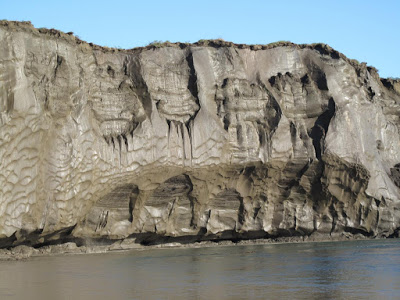
Researchers from the U.S. Geological Survey and key academic partners including the University of Colorado Boulder have quantified how rapidly ancient permafrost decomposes upon thawing and how much carbon dioxide is produced in the process.
Huge stores of organic carbon in permafrost soils—frozen for hundreds to tens of thousands of years across high northern latitudes worldwide—are currently isolated from the modern day carbon cycle. However, if thawed by changing climate conditions, wildfire, or other disturbances, this massive carbon reservoir could decompose and be emitted as the greenhouse gases carbon dioxide and methane, or be carried as dissolved organic carbon to streams and rivers.
“Many scientists worldwide are now investigating the complicated potential end results of thawing permafrost,” said Rob Striegl, USGS scientist and study co-author. “There are critical questions to consider, such as: How much of the stored permafrost carbon might thaw in a future climate? Where will it go? And, what are the consequences for our climate and our aquatic ecosystems?”
At a newly excavated tunnel operated by the U.S. Army Corps of Engineers near Fairbanks, Alaska, a research team from USGS, CU-Boulder and and Florida State University set out to determine how rapidly the dissolved organic carbon from ancient (about 35,000 years old) “yedoma” soils decomposes upon soil thaw and how much carbon dioxide is produced.
Yedoma is a distinct type of permafrost soil found across Alaska and Siberia that accounts for a significant portion of the permafrost soil carbon pool. These soils were deposited as wind-blown silts in the late Pleistocene age and froze soon after they were formed.
“It had previously been assumed that permafrost soil carbon this old was already degraded and not susceptible to rapid decomposition upon thaw,” said Kim Wickland, the USGS scientist who led the team.
The researchers found that more than half of the dissolved organic carbon in yedoma permafrost was decomposed within one week after thawing. About 50 percent of that carbon was converted to carbon dioxide, while the rest likely became microbial biomass.
“What this study adds is that we show what makes permafrost so biodegradable,” said Travis Drake, the lead author of the research. “Immediately upon thaw, microbes start using the carbon and then it is sent back into the atmosphere.” Drake was both a USGS employee and a master’s degree student at CU-Boulder during the investigation.
The researchers attribute this rapid decomposition to high concentrations of low molecular weight organic acids in the dissolved organic carbon, which are known to be easily degradable and are not usually present at high concentrations in other soils.
These rates are among the fastest permafrost decomposition rates that have been documented. It is the first study to link rapid microbial consumption of ancient permafrost soil-derived dissolved organic carbon to the production of carbon dioxide.
An important implication of the study for aquatic ecosystems is that dissolved organic carbon released by thawing yedoma permafrost will be quickly converted to carbon dioxide and emitted to the atmosphere from soils or small streams before it can be transported to major rivers or coastal regions.
The research was recently published in the Proceedings of the National Academy of Sciences.
Reference:
Ancient low–molecular-weight organic acids in permafrost fuel rapid carbon dioxide production upon thaw, www.pnas.org/cgi/doi/10.1073/pnas.1511705112
Note: Note: The above post is reprinted from materials provided by University of Colorado Boulder, Florida State University, National Science Foundatio.










